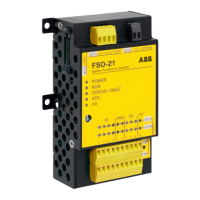470 Verification and validation
Validation of the SSE function
Always configure and validate the SSE function. Test the SSE function always with a
separate function request, for example by activating it via a suitable input configured
for the SSE.
Internal diagnostics of the FSO module, trip limit hit cases and PROFIsafe
passivation will trigger the SSE function even if you have not defined an external
request signal for the SSE. For example, the FSO module activates the SSE function
if an SLS trip limit hit occurs. The SSE function must be configured as SSE with STO,
SSE with ramp stop, or SSE with time monitoring, based on the risk assessment of
the application. The configuration must also cover the worst-case situation in case
any of the issues above triggers the SSE function, or in case any stopping function
with the SSE triggers the SSE.
Validation of the SSE with immediate STO function with safe speed estimation
1. Make sure that the input for the SSE function is configured according to the wiring
diagram.
2. Make sure that the SSE function is configured correctly according to your design.
For a configuration example, see chapter How to configure SSE with immediate
STO on page 351). Check these settings:
Activation:
• SSE.11 SSE input A
• SSE.12 SSE input B.
• Note: Activation can also come from the PROFIsafe.
Acknowledgement:
• STO.02 STO acknowledgement
• FSOGEN.42 Acknowledgement button input if manual acknowledgement is
used.
Functionality:
• SSE.13 SSE function = Immediate STO
• STO.14 Time to zero speed with STO and modoff. (STO.14 is the time in
which the motor coasts to a stop from the maximum speed.)
Indication:
• SSE.21 SSE output
• SSE.22 SSE completed output
• FSOGEN.11 Stop completed output.
3. If you made any changes, download and validate the configuration with the Drive
composer pro PC tool.
4. Make sure that you can run and stop the motor freely. Start the drive.

